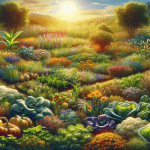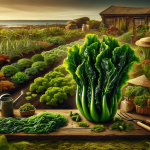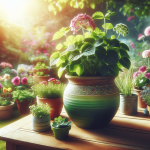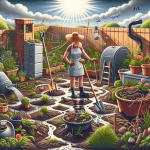This post may contain affiliate links. As an Amazon Associate, we may earn commissions from qualifying purchases.
Creating a wildlife-friendly garden is easier than you might think and immensely rewarding for both you and local wildlife. This article will guide you through simple, thoughtful steps to transform your outdoor space into a thriving haven for birds, bees, butterflies, and other critters. By incorporating native plants, providing food and water sources, and creating shelter, you can make a positive impact on your environment while enjoying the beauty and activity of a bustling natural habitat right in your own backyard. Dive into these practical tips and discover the joy of a garden teeming with life. Have you ever wondered how you can transform your garden into a wildlife haven? Imagine stepping outside and witnessing a ballet of butterflies, listening to the melodious chirping of birds, and discovering a variety of insects that add life and vibrancy to your surroundings. Creating a wildlife-friendly garden is not only a rewarding endeavor but also a significant contribution to the environment. Let’s dive into the delightful journey of transforming your garden into a sanctuary for wildlife.
Understanding the Basics of a Wildlife-friendly Garden
What is a Wildlife-friendly Garden?
A wildlife-friendly garden is a space designed to attract and support a diverse range of species, from birds and insects to small mammals. It involves creating habitats that provide food, water, shelter, and breeding grounds for various forms of wildlife. By adopting eco-friendly practices and planting native species, you can create a miniature ecosystem right in your backyard.
Why Should You Create a Wildlife-friendly Garden?
Creating a wildlife-friendly garden offers numerous benefits:
- Biodiversity: Encourages a wide variety of plants and animals to thrive.
- Pest Control: Natural predators help manage garden pests.
- Pollination: Attracts pollinators like bees and butterflies, essential for flowering plants.
- Sustainability: Reduces the need for chemical pesticides and fertilizers.
- Aesthetics: A wildlife garden can be extraordinarily beautiful and lively.
Planning Your Wildlife-friendly Garden
Assessing Your Garden’s Potential
Before you start planting, take some time to observe your garden. Note the types of existing plants, soil quality, sunlight exposure, and water sources. Understanding your garden’s characteristics will help you make informed decisions.
Setting Goals
What kind of wildlife do you want to attract? Birds, butterflies, bees, or perhaps small mammals? Setting clear goals will guide your planting and design choices.
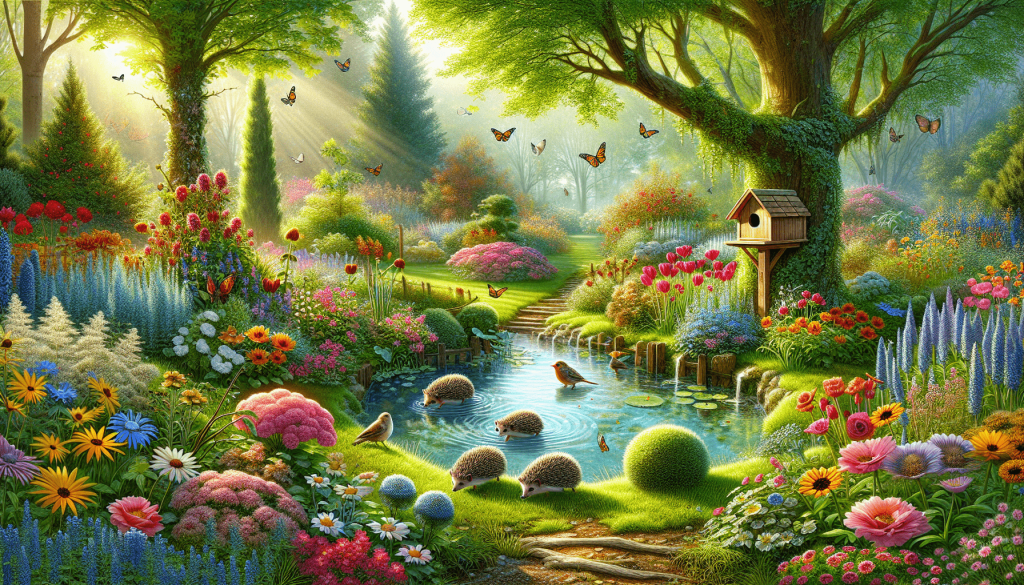
Planting for Wildlife
Choosing Native Plants
Native plants are adapted to your local climate and soil, making them easier to maintain. They also provide the most suitable food and shelter for local wildlife.
| Native Plant | Attracts | Benefits |
|---|---|---|
| Milkweed | Butterflies, especially Monarchs | Provides food for caterpillars |
| Coneflowers (Echinacea) | Bees, Butterflies | Nectar source, drought-tolerant |
| Oaks | Birds, Small Mammals | Shelter, food (acorns) |
| Asters | Bees, Butterflies | Late-season nectar source |
| Black-eyed Susans | Butterflies, Birds | Nectar, seeds for birds |
Creating Layers in Your Garden
Different species thrive in different levels of a garden. Creating layers—ground cover, shrubs, and trees—mimics natural habitats and supports a variety of wildlife.
- Ground Cover: Plants like clover, thyme, or sedges attract insects and provide shelter.
- Shrubs and Bushes: Offer nesting sites and food (berries or seeds).
- Trees: Essential for birds and squirrels, providing nesting sites and shade.
Planting Strategies
- Clumping: Planting flowers in clusters rather than singly attracts more pollinators.
- Seasonal Blooms: Choose plants that bloom at different times of the year to provide continuous food sources.
Providing Water Sources
Water Features
A reliable water source is crucial for attracting wildlife. Options include bird baths, ponds, and shallow dishes. Ensure the water is clean and refilled regularly.
Creating a Pond
Creating a pond, even a small one, can significantly boost the biodiversity of your garden.
Tips for a Successful Pond:
- Gradual Slopes: Create shallow edges so animals can easily access the water.
- Aquatic Plants: Plants like water lilies and reeds provide cover and breeding grounds.
- Avoid Fish: Fish can prey on insects and amphibian larvae, reducing biodiversity.
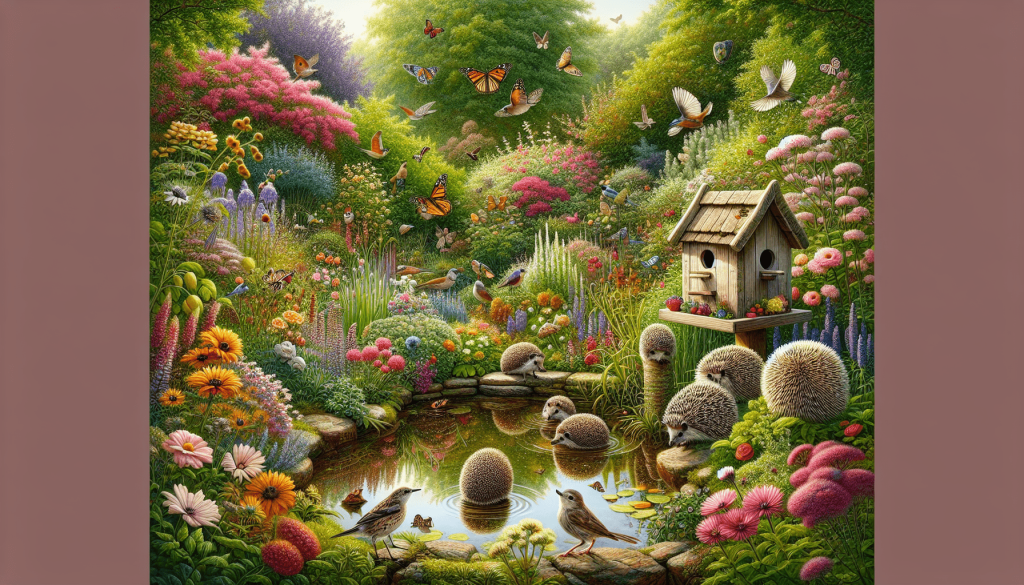
Providing Shelter and Nesting Sites
Birdhouses and Feeders
Install birdhouses suitable for your local bird species. Position feeders in visible yet safe spots to attract birds.
Insect Hotels
Insect hotels provide shelter for beneficial insects like bees, ladybugs, and beetles. Place them in sunny locations sheltered from the wind.
Log Piles and Rockeries
Creating log piles or rockeries provides hiding and breeding places for insects, small mammals, and amphibians.
Hibernation Sites
Create hibernation sites by leaving some areas of your garden undisturbed. Piles of leaves, compost heaps, or dense vegetation can serve as safe overwintering spots for many species.
Avoiding Chemicals
Organic Gardening Practices
Avoid using chemical pesticides and fertilizers, which can harm the delicate balance of your garden ecosystem. Opt for organic alternatives and natural pest control methods instead.
Companion Planting
Certain plants can deter pests and attract beneficial insects. For example, planting marigolds near vegetables can repel aphids.
Encouraging Sustainable Practices
Composting
Composting kitchen scraps and garden waste enriches the soil, reduces waste, and supports a range of organisms.
Water Conservation
Implement rain barrels to collect and reuse rainwater for your garden. Mulching helps retain soil moisture and reduces the need for frequent watering.
Recycling and Upcycling
Incorporate recycled materials into your garden design. Old pallets can become raised beds, or glass bottles can be transformed into garden edging.
Engaging with the Community
Join Local Wildlife Groups
Joining local wildlife or gardening groups can provide valuable resources and advice. You might also find opportunities to participate in community gardens.
Education and Outreach
Share your successes and knowledge with neighbors and friends. Awareness can inspire others to create their own wildlife-friendly gardens.
Monitoring and Maintaining Your Garden
Regular Observations
Keep a journal to track the types of wildlife visiting your garden and any notable behaviors or changes.
Adaptive Management
Be prepared to adapt your garden based on observations. If a particular plant isn’t thriving or attracting wildlife, try replacing it with another species.
Continuous Learning
Wildlife gardening is a journey. Stay informed through books, online resources, and joining local workshops or garden tours.
Conclusion
By now, you should have a solid plan and understanding of how to create a thriving wildlife-friendly garden. Remember, the process is as rewarding as the end result. As you observe the increasing biodiversity and vibrancy in your garden, you’ll find joy and satisfaction in knowing you are contributing positively to the environment. Happy gardening!

